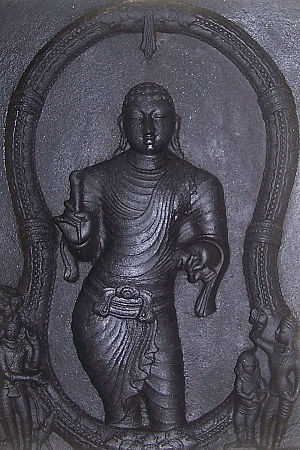Portal:Tamils
Portal maintenance status: (June 2018)
|
The Tamils portal
The Tamils (/ˈtæmɪlz, ˈtɑː-/ TAM-ilz, TAHM-), also known as the Tamilar, are a Dravidian ethnolinguistic group who natively speak the Tamil language and trace their ancestry mainly to the southern part of the Indian subcontinent. The Tamil language is one of the longest-surviving classical languages, with over two thousand years of written history, dating back to the Sangam period (between 300 BCE and 300 CE). Tamils constitute about 5.7% of the Indian population and form the majority in the South Indian state of Tamil Nadu and the union territory of Puducherry. They also form significant proportion of the population in Sri Lanka (15.3%), Malaysia (7%) and Singapore (5%). Tamils have migrated world-wide since the 19th century CE and a significant population exists in South Africa, Mauritius, Fiji, as well as other regions such as the Southeast Asia, Middle East, Caribbean and parts of the Western World.
Archaeological evidence from Tamil Nadu indicates a continuous history of human occupation for more than 3,800 years. In the Sangam period, Tamilakam was ruled by the Three Crowned Kings of the Cheras, Cholas and Pandyas. Smaller Velir kings and chieftains ruled certain territories and maintained relationship with the larger kingdoms. Urbanisation and mercantile activity developed along the coasts during the later Sangam period with the Tamils influencing the regional trade in the Indian Ocean region. Artifacts obtained from excavations indicate the presence of early trade relations with the Romans. The major kingdoms to rule the region later were the Pallavas (3rd–9th century CE), and the Vijayanagara Empire (14th–17th century CE). The island of Sri Lanka often saw attacks from the Indian mainland with the Cholas establishing their influence across the island and across several areas in Southeast Asia in the 10th century CE. This led to the spread of Tamil influence and contributed to the cultural Indianisation of the region. Scripts brought by Tamil traders like the Grantha and Pallava scripts, induced the development of many Southeast Asian scripts. The Jaffna Kingdom later controlled the Tamil territory in the north of the Sri Lanka from 13th to 17th century CE. European colonization began in the 17th century CE, and continued for two centuries until the middle of the 20th century. (Full article...) Selected article -There are literary, archaeological, epigraphic and numismatic sources of ancient Tamil history. The foremost among these sources is the Sangam literature, generally dated to 5th century BCE to 3rd century CE. The poems in Sangam literature contain vivid descriptions of the different aspects of life and society in Tamilakam during this age; scholars agree that, for the most part, these are reliable accounts. Greek and Roman literature, around the dawn of the Christian era, give details of the maritime trade between Tamilakam and the Roman empire, including the names and locations of many ports on both coasts of the Tamil country. Archaeological excavations of several sites in Tamil Nadu and Kerala have yielded remnants from the Sangam era, such as different kinds of pottery, pottery with inscriptions, imported ceramic ware, industrial objects, brick structures and spinning whorls. Techniques such as stratigraphy and paleography have helped establish the date of these items to the Sangam era. The excavated artifacts have provided evidence for existence of different economic activities mentioned in Sangam literature such as agriculture, weaving, smithy, gem cutting, building construction, pearl fishing and painting. (Full article...) General imagesSelected biography - Ilan kovadigal (Tamil: இளங்கோவடிகள், Malayalam: ഇളങ്കോവടികൾ, romanized: Iḷaṅkōvaṭikaḷ) was a monk and a poet, sometimes identified as a Chera prince. He is traditionally credited as the author of Cilappatikaram, one of the Five Great Epics of Ancient Tamil literature. He is one of the greatest poets from Cheranadu (now Kerala). In a patikam (prologue) to the epic poem, he identifies himself as the brother of a famous Chera king Ceṅkuṭṭuvan (Senguttuvan). This Chera king, as stated by Elizabeth Rosen, ruled over his kingdom in late 2nd or early 3rd century CE. However, this is doubtful because a Sangam poem in Patiṟṟuppattu – the fifth ten – provides a biography of Ceṅkuṭṭuvan, his family and rule, but never mentions that he had a brother who became an ascetic or wrote one of the most cherished epics. This has led scholars to conclude that the legendary author Ilango Adikal myth was likely inserted later into the epic. In a 1968 note, Kamil Zvelebil suggested that, "this [Adigal claim] may be a bit of poetic fantasy, practised perhaps by a later member of the Chera Dynasty [5th or 6th century] recalling earlier events [2nd or 3rd century]". (Full article...) CategoriesTopicsRelated portalsLua error in mw.title.lua at line 346: bad argument #2 to 'title.new' (unrecognized namespace name 'Portal'). WikiProjectsThings to doAssociated WikimediaThe following Wikimedia Foundation sister projects provide more on this subject:
Discover Wikipedia using portals |



















